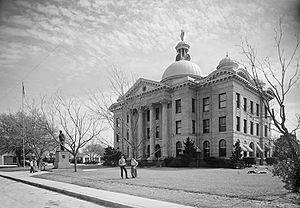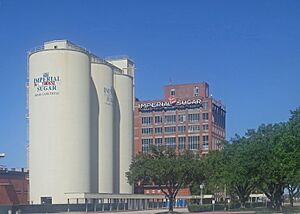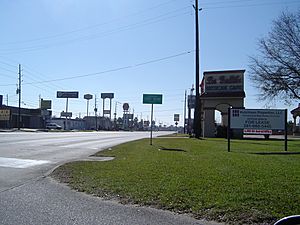Fort Bend County, Texas facts for kids
Quick facts for kids
Fort Bend County
|
||
|---|---|---|
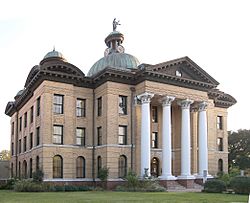
Fort Bend County Courthouse, Richmond, November 2008
|
||
|
||
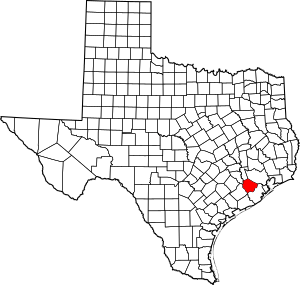
Location within the U.S. state of Texas
|
||
 Texas's location within the U.S. |
||
| Country | ||
| State | ||
| Founded | 1838 | |
| Named for | A blockhouse positioned in a bend of the Brazos River | |
| Seat | Richmond | |
| Largest city | Sugar Land | |
| Area | ||
| • Total | 885 sq mi (2,290 km2) | |
| • Land | 861 sq mi (2,230 km2) | |
| • Water | 24 sq mi (60 km2) 2.7% | |
| Population
(2020)
|
||
| • Total | 822,779 | |
| • Estimate
(2022)
|
889,146 |
|
| • Density | 929.7/sq mi (358.96/km2) | |
| Time zone | UTC−6 (Central) | |
| • Summer (DST) | UTC−5 (CDT) | |
| Congressional districts | 7th, 9th, 22nd | |
Fort Bend County is a county in the U.S. state of Texas. It was started in 1837 and officially organized in 1838. The county gets its name from a special fort built in a bend of the Brazos River.
The main town, or county seat, is Richmond. The biggest city completely inside the county is Sugar Land. Fort Bend County is part of the larger Houston–The Woodlands–Sugar Land area. In 2020, about 822,779 people lived here. Forbes magazine even said it was one of the fastest-growing counties in the United States in 2017.
Fort Bend County is also known for being one of the wealthiest counties in Texas. In 2015, families living here had a median income of over $105,000.
Contents
History
Long ago, before Europeans arrived, the Karankawa Indians lived in this area. Spanish explorers didn't settle much here.
After Mexico became independent from Spain, people from the eastern United States began to move in. In 1822, a group led by Stephen F. Austin's colonists built a fort. This fort was located where Richmond is today. They called it Fort Bend because it was in a bend of the Brazos River. Richmond became an official town in 1837. Fort Bend County was created in 1838 from parts of other counties.
The county's early economy relied on large farms called plantations. These farms grew cotton and used many enslaved African Americans as workers. By the 1850s, more than twice as many enslaved people lived in Fort Bend County as white people.
After the Civil War, formerly enslaved people, called freedmen, gained new rights. They supported the Republican Party and elected their own leaders. However, many white residents, mostly from the Democratic Party, wanted to regain control. This led to a big political fight known as the Jaybird–Woodpecker War in 1888–89.
The conflict became violent, with a gun battle at the courthouse. The governor sent in soldiers to stop the fighting. Afterward, a group called the "Jaybirds" took control. They created a "White-only pre-primary" election. This rule stopped African Americans from voting in the most important local elections. This unfair practice lasted until 1950. Finally, in 1953, the Supreme Court of the United States declared it illegal.
20th century to present
Starting in the 1960s, Fort Bend County began to change a lot. It went from being mostly rural with farms and oil interests to a busy suburban area. New, planned communities were built. These included places like Sugar Creek and Quail Valley.
Later, developments like First Colony in Sugar Land grew. This area became a major shopping and business center. More communities like Greatwood, New Territory, and Sienna also appeared. The Greater Katy area also expanded into Fort Bend County. By 2010, the county's population was over 500,000 people.
In 2017, Hurricane Harvey caused major flooding in Fort Bend County. Many residents had to leave their homes. The Brazos River overflowed, and thousands of homes were damaged.
Geography
Fort Bend County covers about 885 square miles. A small part of this area, about 24 square miles, is covered by water.
Neighboring counties
- Waller County (north)
- Harris County (northeast)
- Brazoria County (southeast)
- Wharton County (southwest)
- Austin County (northwest)
Communities
Cities (multiple counties)
- Houston (mostly in Harris County)
- Katy (partly in Harris and Waller Counties)
- Missouri City (small part in Harris County)
- Pearland (mostly in Brazoria County)
- Stafford (small part in Harris County)
Cities
Town
Villages
Census-designated places
These are areas that are not officially cities or towns but are recognized for census purposes.
- Cinco Ranch (small part in Harris County)
- Cumings
- Fifth Street
- Four Corners
- Fresno
- Greatwood
- Mission Bend (partly in Harris County)
- Pecan Grove
- Sienna
Unincorporated communities
These are areas that are not part of any city or town.
- Booth
- Clodine
- Crabb
- Foster
- Guy
- Juliff
- Long Point
- Powell Point
- Riverstone
- Tavener
Population and Diversity
Fort Bend County has grown a lot, especially since the 1970s. It has become a very diverse place. In fact, a study in 2001 said it was one of the most diverse counties in the U.S. for its size.
Many different ethnic groups live here, and no single group makes up the majority. Fort Bend County has the highest percentage of Asian Americans in the Southern United States. The largest groups include people of Vietnamese, Chinese, Indian, and Filipino backgrounds. In 2011, USA Today ranked it as the fourth most racially diverse county in the country. This means there's a high chance that two random people you meet would be from different ethnic or racial backgrounds.
Between 2010 and 2020, the number of Asian Americans in the county grew by over 83,000 people. The Hispanic population also increased by almost 43%, and the Black population grew by nearly 36%.
Economy
Fort Bend County has a varied economy. It has many jobs in healthcare, energy, education, and hospitality. Big companies like Schlumberger, Minute Maid, and Fluor have operations here. The county's diverse industries have helped it grow quickly over the years. Many doctors and hospitals have also moved to the county.
Education
Public school districts
Students in Fort Bend County attend schools in several different districts:
- Brazos Independent School District
- Fort Bend Independent School District
- Katy Independent School District
- Lamar Consolidated Independent School District
- Needville Independent School District
- Stafford Municipal School District
Higher education
- University of Houston Sugar Land campus
- Houston Community College System (for some areas)
- Wharton County Junior College (for other areas, including Sugar Land)
Technical school
- Texas State Technical College
Libraries
Fort Bend County Libraries runs many libraries throughout the county. The Houston Public Library also has one branch in the county.
Transportation
Major highways
 Interstate 10
Interstate 10 Interstate 69
Interstate 69 U.S. Route 59
U.S. Route 59
 U.S. Route 90 Alternate
U.S. Route 90 Alternate State Highway 6
State Highway 6 State Highway 36
State Highway 36 State Highway 99 — Grand Parkway
State Highway 99 — Grand Parkway Fort Bend Parkway
Fort Bend Parkway Westpark Tollway
Westpark Tollway
Major Farm to Market Roads
These are state-maintained roads that connect rural areas to larger highways.
 Farm to Market Road 359
Farm to Market Road 359 Farm to Market Road 442
Farm to Market Road 442 Farm to Market Road 521
Farm to Market Road 521 Farm to Market Road 762
Farm to Market Road 762 Farm to Market Road 1092
Farm to Market Road 1092 Farm to Market Road 1093
Farm to Market Road 1093 Farm to Market Road 1462
Farm to Market Road 1462 Farm to Market Road 1463
Farm to Market Road 1463 Farm to Market Road 1464
Farm to Market Road 1464 Farm to Market Road 1876
Farm to Market Road 1876 Farm to Market Road 2234
Farm to Market Road 2234 Farm to Market Road 2759
Farm to Market Road 2759 Farm to Market Road 2977
Farm to Market Road 2977 Farm to Market Road 3345
Farm to Market Road 3345
Airports
The main public airport in the county is Sugar Land Regional Airport. There are also several smaller, privately owned airports. For bigger flights, people use William P. Hobby Airport or George Bush Intercontinental Airport in Houston.
Mass transit
Fort Bend County has a public transportation department. It offers bus services for commuters to Houston. It also has buses for senior citizens and the public to travel within the county. Some parts of the county are also served by Houston's Metropolitan Transit Authority of Harris County.
Toll roads
The Fort Bend County Toll Road Authority manages and operates toll roads in the county. These include parts of the Fort Bend Parkway, Westpark Tollway, and Grand Parkway Toll Road.
Notable people
- Brittney Karbowski, an American voice actress
- CeeDee Lamb, a Wide Receiver for the Dallas Cowboys
See also
 In Spanish: Condado de Fort Bend para niños
In Spanish: Condado de Fort Bend para niños



